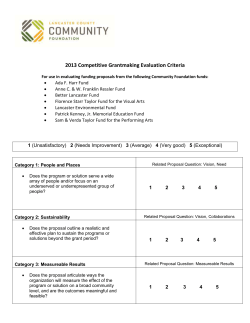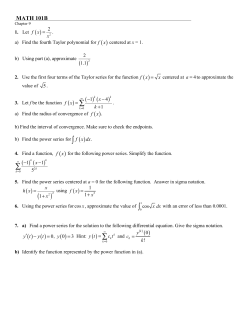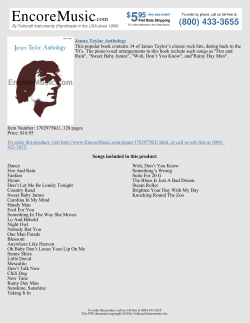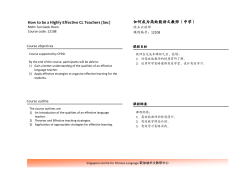
UNIT ONE Theoretical Foundations Classical Theories of Organizations CHAPTER TWO
UNIT ONE Theoretical Foundations CHAPTER TWO Classical Theories of Organizations PREVIEW Review Chapter One Theoretical Relevancy Minimizing Misunderstandings Classical Theories of Organizations Taylor’s Theory of Scientific Management Fayol’s Administrative Theory Weber’s Theory of Bureaucracy Organizational Communication Foundations REVIEW “…the process of creating, exchanging, interpreting (correctly or incorrectly), and storing oral, nonverbal, and written messages within (and across the boundaries of) a system of interrelated and interdependent people working to accomplish common tasks and goals within an organization.” MESSAGE-CENTERED DEFINITION Assumptions and Features Communication is central to the existence of the organization Organizational communication is a complex process (creating, exchanging, interpreting, and storing messages) Misunderstandings occur Misunderstandings “Instances in which people who are communicating don’t share meanings as well as situations in which features of organizational life serve to impinge upon the efficient and effective functioning of organizational members.” Three Important Constructs Organizational Identification (process & product) An active process by which individuals link themselves to elements (people, policies, products, services, customers, values) in the social scene. Involves an individual’s sense of membership in and connection with an organization. Job Satisfaction The degree to which employees feel fulfilled by their job and related experiences. A pleasurable or positive emotional state from the appraisal of one’s job or experiences Linked to absenteeism and turnover Communication Satisfaction The degree to which employees feel that communication is appropriate and satisfies their need for information and work relationships Communication Satisfaction (CSQ) Eight Factors concerned with communication information, relationships, channels, and climate Communication Climate Relationship to Supervisors Organizational Integration Media Quality Horizontal and Informal Communication Organizational Perspective Relationship with Subordinates Personal Feedback Communication satisfaction is often considered the “sum” of an individual’s satisfaction with the above dimensions. Primary Goal Reduce misunderstandings through communication. Theory An explanation for how or why something occurs. . . Question: What is the most efficient and effective means of running an organization? Functions of Theory Describe Explain Predict Control Classical approaches to organizational management and early organizational theories were designed to predict and control behavior in organizations. Classical Theories of Organizations Emerged in early part of the twentieth century. Models were military and the Catholic Church. Features Strict CONTROL of workers Absolute CHAINS of COMMAND PREDICTABILITY of behavior UNIDIRECTIONAL downward influence Classical Theories of Organizations: Relevancy and Metaphor How and Why does studying classical theory help us to understand how modern organizations function and particularly the role that communication plays in effective organizing? What is the metaphor which characterizes the classical approach to organizations? The Metaphor of the Machine Organizations are viewed as if they are machines. Managerial principles Modes of operation Treatment of workers Communication in the organization Properties of Machines Very predictable Rarely deviates from the norm Replace defective parts with other “standard” parts Specific rules exist regarding repair and specific roles Organizational Application Workers behave predictably-management knows what to expect Workers operating outside expectations are replaced Minimizing Misunderstandings Simple: Promote principles of SPECIALIZATION, STANDARDIZATION, and PREDICTABILITY STRICT RULES & REGULATIONS regarding . . . how work is accomplished, who could speak to whom and when, and managing through fear. PROBLEMS Creativity and intelligence are underutilized Increased dissatisfaction Decreased motivation and commitment to task and organization Decreased communication effectiveness and satisfaction Distinguishing Classical Theories “Creative Application Skit” Theory “Matchbook Definition” Describe the theory “in a nutshell” Principles of Management Major Elements of the Theory Application in the Modern Workplace Personal Example(s) How are misunderstandings minimized? What new forms of misunderstandings are created? Unintentional by-products Contributions to occurrences of different problems Taylor’s Theory of Scientific Management Frederick Taylor (1856-1915) “The Father of Scientific Management” Maximize worker capacity and profits PROBLEM: Get employees to work at their maximum capacity PRIMARY FOCUS: TASKS http://www.northstar.k12.ak.us/schools/ryn/projects/inventors/taylor/taylor.html Systematic Soldiering Deliberately working slowly as to avoid expanding more effort than deemed necessary Reasons Reduction in workforce due to decreased need Piecework system of remuneration - raise production requirements without increasing pay Rule of thumb training methods - inefficient Taylor’s Theory of Scientific Management Elements of Scientific Management Scientific design of every aspect of every task Time and Motion Studies Careful selection and training of every task Proper remuneration for fast and high-quality work Maximize output - increase pay Equal division of work and responsibility between worker and manager Underlying Themes Managers are intelligent; workers are and should be ignorant Provide opportunities for workers to achieve greater financial rewards Workers are motivated almost solely by wages Maximum effort = Higher wages Manager is responsible for planning, training, and evaluating Taylor’s Theory of Scientific Management Application in the Modern Workplace Assembly Line Plants as Prototypical Examples “Prisoners of Taylorism” System of Remuneration (quotas - commission) Re-Design - Reengineering Benchmarking Data are used to refine, improve, change, modify, and eliminate organizational processes Lean Manufacturing Fayol’s Administrative Theory Henri Fayol (1841-1925) General and Industrial Management Principles and Elements of Management - how managers should accomplish their managerial duties PRIMARY FOCUS: Management (Functions of Administration) More Respect for Worker than Taylor Workers are motivated by more than money Equity in worker treatment More PRESCRIPTIVE http://www.lib.uwo.ca/business/fayol.html Fayol’s Administrative Theory Five Elements of Management -- Managerial Objectives Planning Organizing Command Coordination Control Keep machine functioning effectively and efficiently Replace quickly and efficiently any part or process that did not contribute to the objectives Fayol’s Administrative Theory Fourteen Principles of Management (Tools for Accomplishing Objectives) Division of work - limited set of tasks Authority and Responsibility - right to give orders Discipline - agreements and sanctions Unity of Command - only one supervisor Unity of Direction - one manager per set of activities Subordination of Individual Interest to General Interest Remuneration of Personnel - fair price for services Centralization - reduce importance of subordinate’s role Scalar Chain - Fayol’s bridge Order - effective and efficient operations Equity - kindliness and justice Stability of Tenure of Personnel - sufficient time for familiarity Initiative - managers should rely on workers’ initiative Esprit de corps - “union is strength” “loyal members” Fayol’s Administrative Theory Positioned communication as a necessary ingredient to successful management Application in the Modern Workplace Fayol’s elements of management are recognized as the main objectives of modern managers Planning - more participatory Organizing - human relationships and communication IMPORTANT TABLE 2.1 Comparison of Managerial Skills (p. 32) Especially applicable for large organizations (military) Weber’s Theory of Bureaucracy Max Weber (1864-1920) German Sociologist Theory of Social and Economic Organization (1947) Principles and Elements of Management - describe an ideal or pure form of organizational structure (general policy and specific commands PRIMARY FOCUS: Organizational Structure Worker should respect the “right” of managers to direct activities dictated by organizational rules and procedures More DESCRIPTIVE http://www2.pfeiffer.edu/~lridener/DSS/Weber/WEBRPER.HTML Weber’s Theory of Bureaucracy Bureaucracy allows for the optimal form of authority - “rational authority” Three types of Legitimate Authority Traditional Authority - past customs; personal loyalty Charismatic Authority - personal trust in character and skills Rational Authority - rational application of rules or laws Weber’s Theory of Bureaucracy Tenets of Bureaucracy Rules Specified sphere of competence Hierarchy Specialized Training Workers do not own technology No entitlement to “official position” by incumbent Everything written down Maintenance of “ideal type” - bureaucracy Weber’s Theory of Bureaucracy Concerned with describing the ideal structure of an organization Cornerstone: existence of written rules The rational application of written rules ensures the promotion of legitimate authority and the effective and efficient functioning of the organization. Weber’s Theory of Bureaucracy Application in the Modern Workplace Large organizations guided by countless rules are bureaucracies Linked with inefficient, slow-moving organizations Organizations have several characteristics of bureaucracies SUMMARY Classical Theories of Organizations (p. 36) Taylor’s Theory of Scientific Management Fayol’s Administrative Theory Weber’s Theory of Bureaucracy All 3 theories attempt to enhance management’s ability to predict and control the behavior of their workers Considered only the task function of communication (ignored relational and maintenance functions of communication) Designed to predict and control behavior in organizations NEXT WEEK Read CHAPTER 3: Humanistic Theories of Organizations (pp. 39-62) Human Relations Theory The Hawthorne Studies McGregor’s Theory X and Theory Y Human Resources Theory Likert’s Systems Theory (Four Systems of Management) Blake and Mouton’s (a.k.a. Blake and McCanse) Managerial Grid
© Copyright 2025














